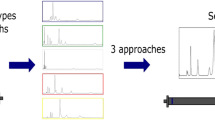Abstract
Stationary phase optimised selectivity liquid chromatography (SOSLC) is an approach to tune a given LC separation by combining different stationary phases in a multi- segment column set-up. The presently available SOSLC optimisation procedure and algorithm are, however, only applicable to isocratic conditions. This is a severe limitation for the analysis of mixtures composed of components covering a broad hydrophobicity range. A strategy is described to circumvent this limitation. The components of a mixture are divided into different groups according to hydrophobicity as elucidated by a gradient analysis on a C18 reversed-phase column. Each group separation is then individually optimised with a specific isocratic mobile phase composition using the original SOSLC strategy. The mobile phase composition thereby only differs in the percentage of organic modifier between the various groups. Finally, a combination of stationary phases that guarantees sufficient selectivity for all the groups is selected and the separation is performed by a multiple step gradient, whereby each level consists of the mobile phase composition applied for the SOSLC optimisation of the individual groups. The multi step gradient approach is demonstrated through the analysis of a mixture of 27 steroids covering a wide range of hydrophobicity.





Similar content being viewed by others
References
Snyder LR (1978) J Chromatogr Sci 16:223–233
Snyder LR, Glajch JL, Kirkland JJ (1981) J Chromatogr A 218:299–326. doi:10.1016/S0021-9673(00)82062-2
Glajch JL, Snyder LR, Kirkland JJ (1982) J Chromatogr A 238:269–277. doi:10.1016/S0021-9673(00)81312-6
Drouen ACJH, Billiet HAH, Schoenmakers PJ, De Galan J (1982) Chromatographia 16:48–52. doi:10.1007/BF02258868
Snyder LR, Dolan JW (1986) Am Lab 18:37–46
Valko K, Snyder LR, Glajch JL (1993) J Chromatogr A 656:501–520. doi:10.1016/0021-9673(93)80816-Q
Snyder LR, Dolan JW (1998) Chem Anal Warsz 43:495–512
Dahlmann G, Koeser HJK, Oelert HH (1979) J Chromatogr Sci 17:307–313
Yu XD, Lin L, Wu CY (1999) Chromatographia 49:567–571. doi:10.1007/BF02467761
Glajch JL, Gluckman JC, Charikofsky JG, Minor JM, Kirkland JJ (1985) J Chromatogr A 318:23–42. doi:10.1016/S0021-9673(01)90661-2
Eppert GJ, Heitmann P (2003) LC-GC Eur 16:698–705
Maier HJ, Karpathy OC (1962) J Chromatogr A 8:308–318. doi:10.1016/S0021-9673(01)99265-9
Wahl JH, McGuffin VL (1989) J Chromatogr A 485:541–556. doi:10.1016/S0021-9673(01)89161-5
Welsch T, Dornberger U, Lerche D (1993) J High Resolut Chromatogr 16:18–26. doi:10.1002/jhrc.1240160104
Lukulay PH, McGuffin VL (1995) J Chromatogr A 691:171–185. doi:10.1016/0021-9673(94)01184-G
Garay F (2000) Chromatographia 51:108–120. doi:10.1007/BF02492792
Dungelova J, Lehotay J, Krupcik J, Welsch T, Armstrong DW (2004) J Chromatogr Sci 42:135–139
Benicka E, Krupcik J, Lehotay J, Sandra P, Armstrong DW (2005) J Liquid Chromatogr Relat Technol 28:1453–1471. doi:10.1081/JLC-200058326
Nyiredy Sz, Szucs Z, Szepesy L (2006) Chromatographia 63:S3–S9. doi:10.1365/s10337-006-0833-7
Nyiredy Sz, Szucs Z, Szepesy L (2007) J Chromatogr A 1157:122–130. doi:10.1016/j.chroma.2007.04.041
Nyiredy Sz, Meier B, Erdelmeier CAJ, Sticher O (1985) J High Resolut. Chromatogr 4:186–188
Halász I, Gerlach HO, Kroneisen A, Walking P (1968) Zeitschr Anal Chem Fresenius 234:97–108. doi:10.1007/BF00508916
Niessen WMA, Vanvliet HPM, Poppe H (1985) Chromatographia 20:357–363. doi:10.1007/BF02269062
De Beer M, Lynen F, Sandra P (2007) Book of Abstracts HPLC 2007. IOPMS, Kortrijk, Belgium, p 265
Gostomski I, Braun R, Huber CG (2008) Anal Bioanal Chem 391:279–288. doi:10.1007/s00216-008-1920-4
Kuehnle M, Rehbein J, Holtin K, Dietrich B, Gradl M, Yeman H, Albert K (2008) J Sep Sci 31:1655–1661. doi:10.1002/jssc.200700604
Author information
Authors and Affiliations
Corresponding author
Rights and permissions
About this article
Cite this article
De Beer, M., Lynen, F., Hanna-Brown, M. et al. Multiple Step Gradient Analysis in Stationary Phase Optimised Selectivity LC for the Analysis of Complex Mixtures. Chroma 69, 609–614 (2009). https://doi.org/10.1365/s10337-008-0942-6
Received:
Revised:
Accepted:
Published:
Issue Date:
DOI: https://doi.org/10.1365/s10337-008-0942-6




